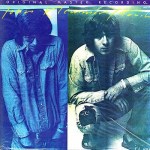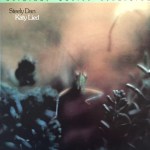 More of the Music of Steely Dan
More of the Music of Steely Dan
Reviews and Commentaries for Aja
Sonic Grade: F
We recently amended this listing. Scroll down to see what we have to say about it in 2023.
More MoFi bashing, but boy does this MoFi deserve it. In our estimation, it is tied with the Cisco 180g pressing (2007) for the worst version ever.
I remember back in 1977 when Aja was released. I was a big Steely Dan fan by then, having been turned on to their albums with Countdown to Ecstasy in 73. With each new Dan record I became more impressed with their music, from Pretzel Logic to Katy Lied to Royal Scam and finally on to this, their commercial breakthrough.
At the time I thought the album sounded pretty good on my plain old ABC original.
Then I got a copy of the Mobile Fidelity pressing and I thought it sounded much, much better. Side two of the MoFi had bass that was only hinted at on my domestic copy. Wow! Listen to all that bass!
Sometime in the 80s, I realized that the MoFi was hideously phony sounding, and that all the bass on side two was boosted far out of proportion to what must be (I’m guessing) on the master tape.
If I May
How much bass is on the master tape is of course of no concern to anyone not mastering the record. The bass has to be right on the record, not the tape.
The song Home At Last has at least an extra three or four DBs added around 50 cycles. It’s ridiculous.
And that’s just the bottom end; the highs are every bit as wrong.
Side one has its top end boosted beyond all understanding. The snare drum that opens the song Black Cow sounds like a hi-hat, all top and no body, and the hi-hat sounds so bright you can barely even tell it’s a hi-hat.
Of course the vocals sharing the midrange are all ridiculously thinned out and compressed to death. The tonality of Fagen’s voice is unlike that found on any other Steely Dan record. That should tell you something.
Fagen’s Evin Twin
Mobile Fidelity was not revealing or discovering the true nature of Donald Fagen’s voice. They were creating an entirely new version of it, one with no relation to the living Donald Fagen, the perfect example of an approach we call giving an old album a new sound.
Mobile Fidelity took this fairly artificial recording and made it even more artificial sounding than it already was. (For a modern version of this approach, check out the Rhino remaster of Rickie Lee Jones’ first album.)
We don’t like it when a mastering engineer creates a new sound for a well-known recording, a sound that nobody involved with the original production could possibly have wanted, for the simple reason that no other version of the album ever sounded like this one.
An Amendment to the Above Remarks
From the view of 2023, I think it would be worthwhile to distinguish between creating an entirely new sound, on the one hand, with simply boosting the hell out of a sound that was already somewhat boosted and phony to start with. It’s hard to draw that line, of course, and this is an Aja with a sound that, unquestionably, never existed before.
But since so many audiophile records, produced by so many different audiophile labels, have boosted bass or boosted highs, or both, you could make the argument that so many of them have a “new sound” that it’s not really a new sound, it’s just the sound audiophile pressings tend to have.
Back to Our Commentary
The MoFi Aja is a giant black mark against Mobile Fidelity and half-speed mastering in general. I’m astonished that anybody who calls himself an audiophile in this day and age would not be able to recognize how laughably wrong it is, but I am sure plenty of people still play the record and like it.
An audiophile record reviewer of dubious expertise was still defending one of the most ridiculously wrong Mobile Fidelity records ever made even as late as 2010, decades after he should have learned recognize the faults of this badly-mastered LP. Is he any more mistaken than the folks that collect this label’s awful records to this very day? Let’s be honest, some people never get the hang of this audio thing, and if you are a collector of this company’s records, you are almost certainly a member of that group. Consider the possibility that you are not yet where you need to be. [1]
The Boost You Need
If you have small speakers, or screens with no subs, it might actually give you some of the bass and highs your speakers have trouble reproducing. This is not a good way to pursue audio of course. We are of the opposite persuasion and have been since 1975 or thereabouts.
This is exactly what is going on with the Speakers Corner Mercury reissue series from about twenty years ago as well. They are finding a Mercury “sound” that no one ever found before. More to the point, they are finding a sound that no one with two working ears would even want.
How Can We Help?
If you can’t tell what’s wrong with the MoFi Aja –and I’m guessing that’s a sizeable contingent of self-described audiophiles — then it’s hard to know how to help you.
Like our friend with the MoFi Aqualung, we would not know where to start. Something ain’t workin’ right — room, stereo, who knows what it might be?
In order to build a record collection of high quality pressings, the first thing you need to do is get good sound.
It is the sine qua non of record collecting. Without it you are almost guaranteed to fail. Until you’ve achieved good sound, you most likely will be wasting money on one bad sounding audiophile record after another, and that would really be a shame.
[1] Pass/ Fail is now Pass/Not-Yet
Some records are so wrong, or are so lacking in qualities that are crucial to hi-fidelity sound — qualities typically found in abundance on the right vintage pressings — that the advocates for these records are failing fundamentally to correctly judge their sound.
We used to call these records Pass-Fail.
As of 2023, we prefer the term “pass/not-yet,” implying that they are not where they need to be in audio yet, but that there is still hope, and if they keep at it, they can get there they same way we did.
Tea for the Tillerman on the new 45 RPM pressing may be unacceptable in many ways, but it is not a complete failure. It lacks one thing above all others, Tubey Magic, so if your system has an abundance of that quality, the way many vintage tube systems do, the new pressing may be quite listenable and enjoyable.
Those whose systems can play the record and not notice this important shortcoming are not exactly failing. They most likely have a system that is heavily colored and not very revealing, but it is a system that is not hopeless.
A system that can play the Mobile Fidelity pressing of Aja from 1980 without revealing how wrong it is is on another level of bad entirely, and that is what would qualify as a system that is ”not yet” where it needs to be.
My system in the ’80s played the MoFi just fine. Looking back on it now, I realize my system was doing more wrong than right.
(more…)
 More of the Music of John Klemmer
More of the Music of John Klemmer
 More of the Music of David Bowie
More of the Music of David Bowie More of the Music of Blondie
More of the Music of Blondie More of the Music of Steely Dan
More of the Music of Steely Dan



